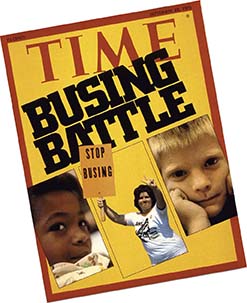SECTION 1: The Conservative Movement Grows

Frustration over controversial issues in the 1970s, such as the busing battle featured on this cover of Time from 1975, lingered into the 1980s. ►
WITNESS HISTORY  AUDIO
AUDIO
Backlash Against Liberal Programs
By 1980, public discontent with liberal programs, from welfare to school busing, had grown considerably. Many middle- and working-class Americans, in particular, felt that the reforms enacted during the 1960s and carried out in the 1970s threatened the American dream.
“If, during the 1960s and 1970s, there was an elite wisdom that shaped the directions of social policy, there was also a popular wisdom that explained why things were falling apart…. The popular wisdom is characterized by hostility toward welfare (it makes people lazy), toward lenient judges (they encourage crime), and toward socially conscious schools (too busy busing kids to teach them to read).”
—Charles Murray, Losing Ground, 1984
Objectives
- Describe the differences between liberal and conservative viewpoints.
- Analyze the reasons behind the rise of conservatism in the early 1980s.
- Explain why Ronald Reagan won the presidency in 1980.
Terms and People
- liberal
- conservative
- New Right
- unfunded mandate
- Moral Majority
- Ronald Reagan
NoteTaking
Reading Skill: Summarize As you read, summarize the rise of the conservative movement in an outline. Use the one below as a starting point.
- Two Views: Liberal and Conservative
- Liberal ideas and goals
Why It Matters The 1964 election marked a low point for conservatives in the post—World War II era. Barry Goldwater, favorite of the conservative movement, lost the election in a landslide. Nonetheless, conservatives were not defeated by this loss at the polls. On the contrary, they set out to build an organization and to put forth a clear vision of their goals and values that would enable them to win in the future. By 1980, their plan had worked: Ronald Reagan, the new hero of the conservatives, was elected President. The modern conservative movement spearheaded by Ronald Reagan deeply affected the nation’s policies for decades. Section Focus Question: What spurred the rise of conservatism in the late 1970s and early 1980s?
Two Views: Liberal and Conservative
The two major political parties in the United States in the late twentieth century were the Democrats, many of whom were “liberals,” and the Republicans, who were often labeled “conservatives.” Liberals generally favored government intervention to help the needy, whereas conservatives generally favored allowing the free market, private organizations, and individuals to do that. Although the two parties did agree on many basic issues, including core American values such as freedom and equality, they diverged on many others. In addition, individual members within both parties did not always conform to their party’s majority.




